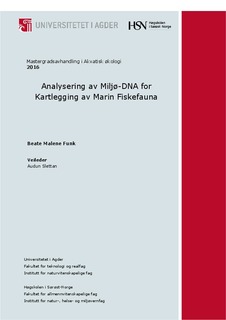| dc.description.abstract | Marine ecosystems worldwide are currently threatened due to overfishing and other humanimpacts. To monitor marine fish, which represents a main component in present monitoring ofmarine ecosystem health, one is mainly depending on invasive and selective methods. Thesemethods are also dependent on physical identification of species, which in many cases can bedifficult, or in some cases, impossible. Such limitations of traditional surveillance methodshave created a demand for alternative methods. One such alternative is the environment-DNAmethod, i.e. analysis of genetic material from a sample collected in the environment.In this paper I explore the possibilities of using environmental-DNA (eDNA) extracteddirectly from marine water samples, to detect selected marine fish species. eDNA samplesfrom eight different stations were collected along the coast of Southern Norway, and analyzedwith species-specific and universal primers. With species-specific primers I could prove thatcod (Gadus morhua) and black goby (Gobius niger) were present in all eight localities. Tostudy the effectiveness of eDNA the results were compared to fish species observed in abeach sine survey in the same areas (conducted by the Institute of Marine Research in Agder,Flødevigen). The beach seine survey could only detect these species in seven of eightlocalities. This confirms earlier findings that shows that the eDNA method has a higherpossibility of detection than conventional methods. With universal primers I could not providea complete list of species present in the different localities, as the primers did not work asexpected. In this paper I conclude that it is possible to use eDNA for species detection inmarine water samples, although more information regarding factors affecting eDNA in marineecosystems is required for good estimates of presence and quantity of species. Nevertheless,the method shows huge potential to become a reliable monitoring method for marine fauna inthe future. | nb_NO |
